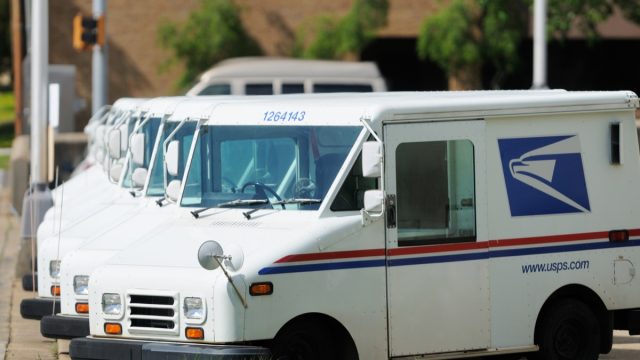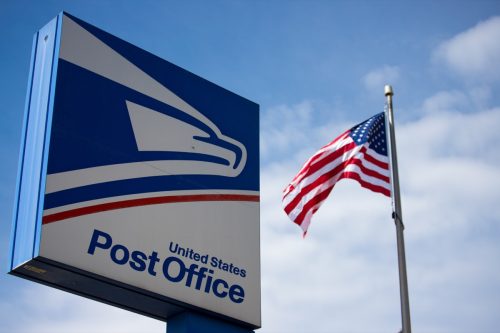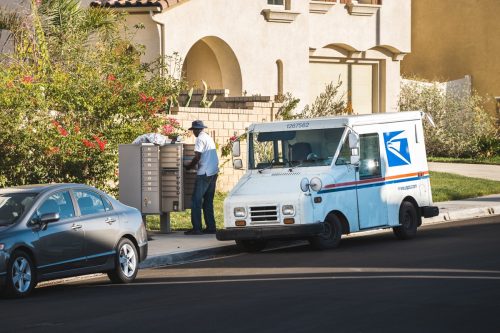USPS Worker Reveals Scary Reality of Delivering Your Summer Mail
Carriers are battling concerning temperatures with little protection.

It's no secret that it's hot this summer—and not just in the standard seasonal way. The U.S. has been battling a brutal heat wave for the past few weeks, and millions of people across the country are facing triple-digit temperatures. But while many of us can stay cooped up indoors with our A/C running, there are letter carriers struggling under the summer sun every day to deliver our mail. As the weather gets hotter and hotter, one U.S. Postal Service (USPS) worker is shedding light on what he has to go through when it comes to summer mail delivery. Read on to find out what USPS workers are currently facing.
RELATED: See a Sticker on Your Mailbox? Don't Touch It, USPS Says.
A letter carrier recently died while delivering mail.

Mail delivery this summer has already proven to be dangerous. On June 20, 66-year-old letter carrier Eugene Gates Jr. collapsed while working his route in Dallas, Texas, The Dallas Morning News reported. According to the newspaper, a homeowner attempted to perform CPR on Gates, but he was eventually pronounced dead after being rushed to the hospital.
A cause of death has not yet been determined, but the carrier's wife Carla Gates said she believes it was the extreme heat. The National Weather Service's (NWS) data indicated that the temperatures reached a high of 98 degrees in the area that day, with a heat index of 115, per The Dallas Morning News.
"He was healthy. He walked eight miles a day, he delivered to 400 homes a day," she told the newspaper. "My husband was an experienced carrier. He was always hydrated. … Being hydrated still didn't save him."
RELATED: USPS Is Making These Changes to Your Mail.
A USPS worker is now sharing the scary reality of summer mail delivery.
Having to deliver mail in scorching heat is something most carriers face. A USPS worker based in Bakersfield, California, has been sharing videos about his experience this summer through his TikTok account, @thepostaldad. In several of his videos, the carrier shares that he has been out working in temperatures as high as 110 degrees.
But while we can get in our cars and blast air conditioning, USPS carriers can't always do the same. In a June 1 TikTok, @thepostaldad shares that this is something many people wonder: "When summer arrives and the weather starts heating up, people start asking me: do those trucks have A/C?"
The answer for many is no. In the video, the mail carrier pans to a small metal fan connected to the dashboard of the truck, indicating that the fan is all they have to keep them cool in the extreme heat. He also shows that he sometimes has to hit the fan just to get it to work.
"And all it does is blow the already hot air on you," another user added in the comments.
RELATED: USPS Mail Carrier Reveals the Greatest Summer Gift You Can Give Them.
Officials have called on the USPS to introduce more protection.

The concerns about postal employees working in extreme heat have reached Congress. Following the death of the carrier in Texas, more than a dozen House lawmakers sent a letter to Postmaster General Louis DeJoy on July 7 to question the agency's protective measures for workers. They indicated that this is not the first "tragic, yet preventable" death that has occurred among the USPS workforce over the years due to exceedingly hot temperatures.
"This is an issue that demands immediate attention," the lawmakers wrote. "With the increase in extreme heat indexes across the country, we have serious concerns that the Postal Service's failure to invest in and fix existing vehicle air-conditioning units and failure to effectively implement policies to reduce employee exposure to extreme conditions place our letter carriers at risk, especially in the coming months."
RELATED: For more up-to-date information, sign up for our daily newsletter.
The agency is warning workers about the risks of heat-related illnesses.

Some actions have already been taken, at least in certain areas. USPS carriers in Texas started working with a revised schedule on June 26, Kimetra Lewis, the Lonestar Branch 132 President of the National Association of Letter Carriers, told Fox 4. They now begin delivering at 7:30 a.m. instead of at 8:30 a.m. to help them finish their shift before the hottest part of the day, according to Lewis.
In its newest Postal Bulletin from July 13, the Postal Service also included a section warning workers about the risk of working in the heat.
"Rising temperatures can put employees at risk for heat illnesses," the agency stated. "When the body is unable to cool itself by sweating, heat illnesses such as heat stress, heat cramps, heat exhaustion, and heat stroke may occur. Symptoms range from mild and easily correctable to severe and potentially life-threatening."
According to the bulletin, the USPS has implemented the Heat Illness Prevention Program (HIPP) to protect employees through education and mandatory heat-related training. The agency is advising carriers to drink at least eight ounces of water every 20 minutes, wear light-colored, loose-fitting clothing, and stick to shaded areas when possible in order to avoid direct sunlight.
"Our carriers deliver the mail throughout the year during varying temperatures and climatic conditions. This includes during the summer months when temperatures rise throughout the country," Albert Ruiz, senior public relations representative for the USPS, said in a statement to Best Life. "In connection with the HIPP, the Postal Service provides mandatory heat-related and other safety training and instruction to all employees and assures they have the resources needed to do their jobs safely. Carriers are reminded to ensure they're hydrated, wear appropriate clothing, including hats, get in the shade whenever possible, and take sufficient amounts of water and ice with them out on their routes. Carriers are further instructed to contact 9-1-1 in the event they begin experiencing any symptoms of heat exhaustion or heat stroke, and they are provided with information to help them identify the symptoms associated with these two forms of heat illness."





















